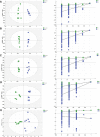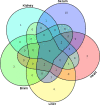Systematic Evaluations of Doxorubicin-Induced Toxicity in Rats Based on Metabolomics
- PMID: 33458487
- PMCID: PMC7807767
- DOI: 10.1021/acsomega.0c04677
Systematic Evaluations of Doxorubicin-Induced Toxicity in Rats Based on Metabolomics
Abstract
Doxorubicin (DOX) is widely used to treat solid tumors, but its use is limited by its severe cardiotoxicity, nephrotoxicity, hepatotoxicity, and neurotoxicity. Metabolomic studies on DOX-induced toxicity are mainly focused on alterations in the heart and kidney, but systematic research on multiple matrices (serum, heart, liver, brain, and kidney) is rare. Thus, in our study, gas chromatography-mass spectrometry analysis of main targeted tissues (serum, heart, liver, brain, and kidney) was used to systemically evaluate the toxicity of DOX. Multivariate analyses, including orthogonal projections to the latent structure and t-test, revealed 21 metabolites in the serum, including cholesterol, d-glucose, d-lactic acid, glycine, l-alanine, l-glutamic acid, l-isoleucine, l-leucine, l-proline, l-serine, l-tryptophan, l-tyrosine, l-valine, MG (0:0/18:0/0:0), MG (16:0/0:0/0:0), N-methylphenylethanolamine, oleamide, palmitic acid, pyroglutamic acid, stearic acid, and urea. In the heart, perturbed metabolites included 3-methyl-1-pentanol, cholesterol, d-glucose, d-lactic acid, glycerol, glycine, l-alanine, l-valine, MG (16:0/0:0/0:0), palmitic acid, phenol, propanoic acid, and stearic acid. For the liver, DOX exposure caused alterations of acetamide, acetic acid, d-glucose, glycerol, l-threonine, palmitic acid, palmitoleic acid, stearic acid, and urea. In the brain, metabolic changes involved 2-butanol, carbamic acid, cholesterol, desmosterol, d-lactic acid, l-valine, MG (16:0/0:0/0:0), palmitic acid, and stearic acid. In the kidney, disturbed metabolites were involved in cholesterol, glycerol, glycine, l-alanine, MG (0:0/18:0/0:0), MG (16:0/0:0/0:0), and squalene. Complementary evidence by multiple matrices revealed disturbed pathways concerning amino acid metabolism, energy metabolism, and lipid metabolism. Our results may help to systematically elucidate the metabolic changes of DOX-induced toxicity and clarify the underlying mechanisms.
© 2020 American Chemical Society.
Conflict of interest statement
The authors declare no competing financial interest.
Figures




Similar articles
-
(1)H NMR based metabolomic profiling revealed doxorubicin-induced systematic alterations in a rat model.J Pharm Biomed Anal. 2016 Jan 25;118:338-348. doi: 10.1016/j.jpba.2015.10.026. Epub 2015 Oct 30. J Pharm Biomed Anal. 2016. PMID: 26595282
-
The effect of tacrolimus-induced toxicity on metabolic profiling in target tissues of mice.BMC Pharmacol Toxicol. 2022 Nov 28;23(1):87. doi: 10.1186/s40360-022-00626-x. BMC Pharmacol Toxicol. 2022. PMID: 36443830 Free PMC article.
-
Metabolomic Profiling Revealed Potential Biomarkers in Patients With Moyamoya Disease.Front Neurosci. 2020 Apr 21;14:308. doi: 10.3389/fnins.2020.00308. eCollection 2020. Front Neurosci. 2020. PMID: 32372905 Free PMC article.
-
[Metabolomics study of doxorubicin induced hepatotoxicity].Yao Xue Xue Bao. 2015 Jun;50(6):708-13. Yao Xue Xue Bao. 2015. PMID: 26521441 Chinese.
-
Metabolomics in the development and progression of rheumatoid arthritis: A systematic review.Joint Bone Spine. 2020 Oct;87(5):425-430. doi: 10.1016/j.jbspin.2020.05.005. Epub 2020 May 27. Joint Bone Spine. 2020. PMID: 32473419
Cited by
-
Comprehensive evaluation of caloric restriction-induced changes in the metabolome profile of mice.Nutr Metab (Lond). 2022 Jun 27;19(1):41. doi: 10.1186/s12986-022-00674-4. Nutr Metab (Lond). 2022. PMID: 35761356 Free PMC article.
-
Integrative analysis of toxicometabolomics and toxicoproteomics data: new molecular insights into thiazolidinedione-induced cardiotoxicity.Metabolomics. 2024 Dec 4;21(1):1. doi: 10.1007/s11306-024-02201-3. Metabolomics. 2024. PMID: 39636558 Free PMC article.
-
Different Mechanisms in Doxorubicin-Induced Neurotoxicity: Impact of BRCA Mutations.Int J Mol Sci. 2025 May 15;26(10):4736. doi: 10.3390/ijms26104736. Int J Mol Sci. 2025. PMID: 40429877 Free PMC article. Review.
-
Temporal analysis of doxorubicin-induced cardiac toxicity and hypertrophy.NPJ Syst Biol Appl. 2025 Jul 1;11(1):67. doi: 10.1038/s41540-025-00545-7. NPJ Syst Biol Appl. 2025. PMID: 40593928 Free PMC article.
-
Investigation of Gynura segetum root extract (GSrE) induced hepatotoxicity based on metabolomic signatures and microbial community profiling in rats.Front Microbiol. 2022 Aug 9;13:947757. doi: 10.3389/fmicb.2022.947757. eCollection 2022. Front Microbiol. 2022. PMID: 36016788 Free PMC article.
References
LinkOut - more resources
Full Text Sources

